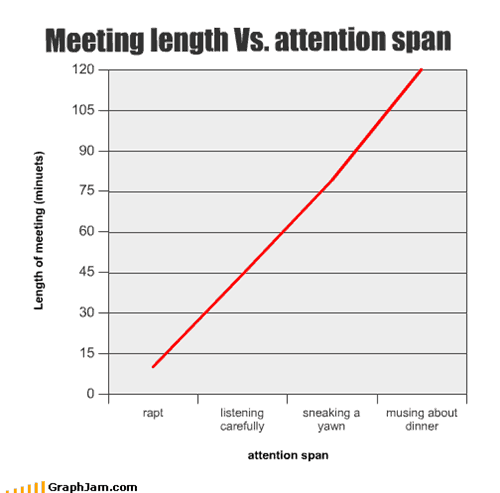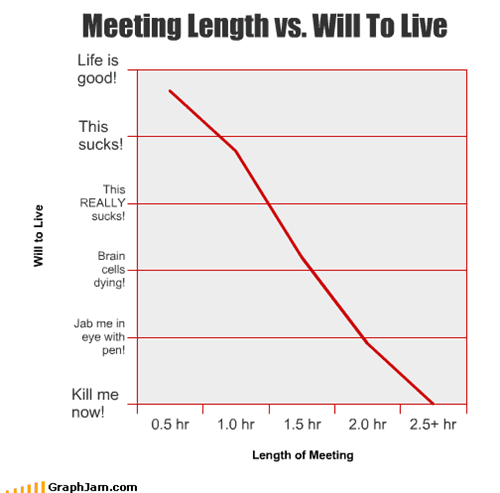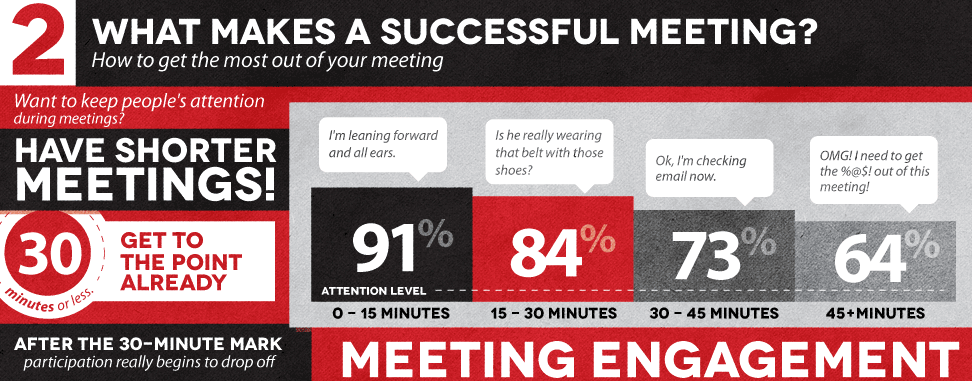
What’s the Connection Between a Productive Meeting, REM Sleep and Attention Span?

Meetings are considered an interruption. Nobody likes interruptions. Even when meetings are planned, they cause a perceived down-shift in productivity and upswing in mental expense, for possibly little reward. We dread meetings, we dread planning for them, participating in them and when they’re long, we’re too wiped to feel relief when it’s all over to actually be productive again.
One of the fundamental questions to consider regarding a meeting is its length. There has been a lot written and discussed about meeting structure, impact on morale and staff productivity but I wanted to dive down a bit more into what factors drive the perfect meeting length.
These infographics, although somewhat of a parody, are very telling:
Question of the day: In general, what is the ideal meeting length?
-
15 minutes
-
45 minutes
-
60 minutes
Answer: B. Many experts agree that 45 minutes represents the best meeting length, making it one of the few fixed variables you can take into account when planning a meeting. Oddly enough, it also represents about one-half a human REM sleep cycle. Given the glazed eyes and snores that often accompany long meetings, you have to wonder how closely these two facts are related.
This infographic from SalesCrunch is also very telling. They were able to measure when people are paying attention in their meetings versus when they lose focus doing other things, like checking email. Their review of thousands of meetings revealed the optimal length of a meeting based on how long people tend to pay attention and at which point they tend to drift off. Not surprising, they found that after the 30-minute mark, participation really begins to drop off.
Although meetings are often excessive in number, too long and misused, if conducted well and made for the right reasons, they can be incredibly effective and efficient.
Here are seven time-tested techniques to ensure better meetings:
-
Have an agenda: Instead of just listing the topics to be discussed, the agenda item should list the expected outcome, for example, an agreement on a new pay structure. That reduces the risk that the meeting will be all jawboning and no outcome.
-
Distribute the agenda and any pre-work at least 24-48 hours in advance: This encourages participants to come prepared for the meeting and be immediately engaged. Also include the time allocated to each item. Knowing the allocated time encourages people to be time-effective in their comments during the meeting.
-
Start on time and end on time: Always start your meeting on time regardless of whether you have a couple of late comers. This shows you value your participants’ time and hopefully, the tardy ones will show up on time in the future. Consider implementing a late fine – $1 for every minute late.
Starting late = Poor organization = Running late = Major dread
-
Maintain the focus: Meetings can easily get off track. Meeting leaders and participants must actively work to keep meetings focused on the agenda items. Learn how to tactfully cut off long-winded or tangential statements from participants. This is one of the major reasons why people hate meetings. You’ll be appreciated for cutting them off. If the participants are starting to look bored, pick up the pace, stand up, start speaking louder and more quickly to arouse the participants.
-
Take notes, capture and assign action items: At the start of the meeting, make sure someone has been assigned to take notes. Don’t assume that all participants are going to take their assignments to heart and remember all the details. Summarize the outcome of the meeting; include assignments and timelines and email a copy of this summary within 24 hours after the meeting.
-
Get feedback: At the end of each meeting, review its effectiveness and suggest improvements for the next meeting. Be sure to solicit feedback from meeting participants. Was the meeting too long? Did one person dominate the discussion? Were attendees unprepared? Were the items on the agenda unclear? Make sure you fix them prior to the next meeting.
-
Have fewer (but better) meetings: Call a meeting only when it is absolutely necessary. Ask yourself whether you can achieve your goal in some other way such as an online meeting. If possible, meetings should not be scheduled first thing in the morning. That’s when people are the freshest and should be working on activities requiring maximum performance. By scheduling your meeting just before lunch or at the end of the day it encourages people to stay within the time limit – they want to get out or go home.
Here are some other great tools/ideas to improve your meeting effectiveness:
-
Have a check your cell phones and laptops at the door policy
-
No meetings on Fridays. Tuesday at 3 pm represents the best overall time to hold a local meeting.
-
Don’t have a meeting if a simple phone call will do
-
Send more emails
-
Use IM/Chat tools
-
Use online tools to have your team report on their daily activities (for example – idonethis.com)
-
Don’t forget to provide fruit and snacks especially if the meeting is longer than 45 minutes. (A shout out to my friends at the Sonoma Valley Education Foundation and their well-stocked meeting pantry!)
I ran across an interesting article on The Seven Sins of Deadly Meetings from way back in 1996, touting Intel as having the right mindset when it comes to meeting effectiveness.
Walk into any conference room at any Intel factory or office anywhere in the world and you will see a poster on the wall with a series of simple questions about the meetings that take place there: Do you know the purpose of this meeting? Do you have an agenda? Do you know your role? Every new employee, from the most junior production worker to the highest ranking executive, is required to take the company’s course on effective meetings.
What a great example of an organization that takes its meetings very seriously and surprisingly, just as relevant today as in 1996. Think meetings are a time drain or necessary part of your business? If you have ideas on how to limit meetings or make them more productive let us know!






